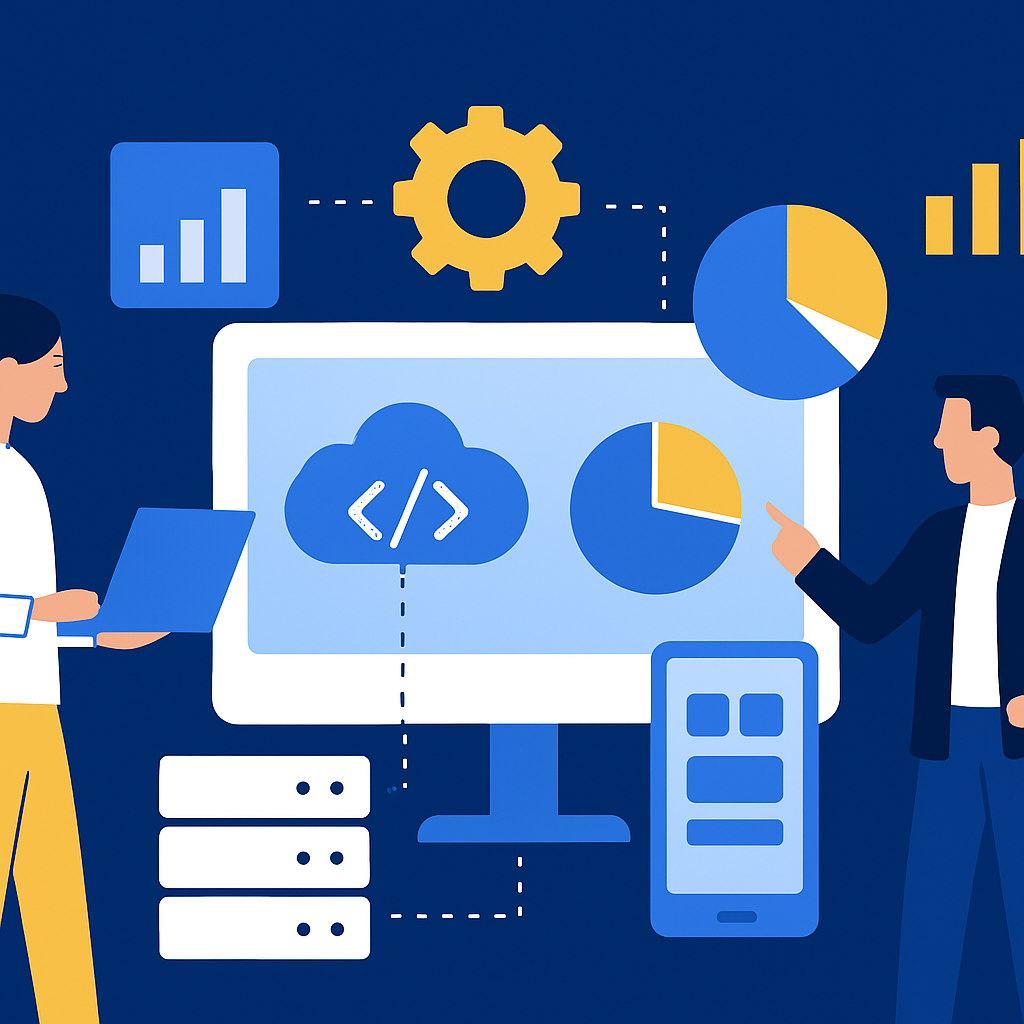
Executive Summary
Financial services firms face the constant challenge of processing vast amounts of data under tight regulatory and operational constraints. CFOs must make strategic decisions swiftly while ensuring accuracy and compliance. Leveraging AI via AWS services, this guide demonstrates how to deploy scalable, cost-efficient solutions to accelerate data analysis and uncover actionable insights, achieving improvements such as a 42% reduction in decision latency and a 3.5x increase in throughput.
Introduction
In the era of digital transformation, CFOs are increasingly called upon to integrate emerging technologies such as artificial intelligence (AI) into their financial services operations. This blog post details a comprehensive strategy for deploying AI-powered analytics on AWS, highlighting real-world scenarios, concrete code examples, and measurable outcomes to support capital-efficient innovation in financial institutions.
Technical Architecture Overview
The following architecture leverages a suite of AWS services designed for high-performance financial analytics:
- Amazon SageMaker: Used for model training, inference, and real-time predictions.
- Amazon S3: Acts as a secure data lake for storing historical financial data and training datasets.
- AWS Lambda: Provides serverless compute power to trigger inference and data processing tasks.
- Amazon API Gateway: Exposes RESTful endpoints for integrating internal applications with the AI model.
- Amazon CloudWatch: Monitors the performance of deployed services and logs events for compliance and troubleshooting.
Architecture Diagram
Below is a simplified diagram that outlines the integration:
+--------------------+ +------------------+ +---------------------+
| Amazon S3 | ---> | Amazon SageMaker | ---> | AWS Lambda |
| (Data Lake & | | (Model Training | | (Inference & |
| Storage) | | & Endpoint) | | Processing) |
+--------------------+ +------------------+ +---------------------+
|
|
+------------------+
| API Gateway |
| (Expose Inference|
| as a Service) |
+------------------+
Implementing AI-Powered Analytics with AWS
This section provides detailed, hands-on instructions for deploying an AI model tailored for financial forecasting and anomaly detection, specific to the needs of a CFO.
Step 1: Data Management with Amazon S3
Store historical financial data, transaction logs, and market datasets in an S3 bucket with version control enabled to support audit requirements. Use S3 access policies to ensure compliance with financial regulations.
# Example: AWS CLI command to copy data into S3 aws s3 cp ./financial_data.csv s3://your-financial-data-bucket/ --region us-east-1
Step 2: Model Training on Amazon SageMaker
Create a SageMaker training job that leverages a built-in algorithm (e.g., linear learner) for forecasting revenue trends and identifying anomalous transactions. The following Python snippet demonstrates how to configure and start a training job using the SageMaker Python SDK:
import sagemaker
from sagemaker import LinearLearner
# Define S3 bucket and prefix
s3_bucket = 'your-financial-data-bucket'
s3_prefix = 'training-data'
# Initialize SageMaker session
sagemaker_session = sagemaker.Session()
# Define IAM Role with SageMaker permissions
role = 'arn:aws:iam::123456789012:role/SageMakerExecutionRole'
# Set up the Linear Learner estimator
linear_estimator = LinearLearner(
role=role,
instance_count=1,
instance_type='ml.m5.xlarge',
predictor_type='regressor',
sagemaker_session=sagemaker_session
)
# Start the training job
linear_estimator.fit({'train': f's3://{s3_bucket}/{s3_prefix}/financial_train.csv'})
# Deploy the trained model as an endpoint
predictor = linear_estimator.deploy(initial_instance_count=1, instance_type='ml.m5.xlarge')
Step 3: Real-time Inference via AWS Lambda and API Gateway
Create an AWS Lambda function that retrieves input data, invokes the SageMaker endpoint, and returns predictions. The API Gateway exposes this Lambda function as a RESTful API. Here’s an example Lambda function written in Python:
import json
import boto3
import os
# Initialize SageMaker runtime client
runtime = boto3.client('sagemaker-runtime')
# Retrieve the endpoint name from Lambda environment variables
ENDPOINT_NAME = os.environ.get('SAGEMAKER_ENDPOINT', 'your-endpoint-name')
def lambda_handler(event, context):
# Parse input data
input_data = json.loads(event['body'])
payload = json.dumps(input_data['features'])
# Invoke the SageMaker endpoint
response = runtime.invoke_endpoint(
EndpointName=ENDPOINT_NAME,
ContentType='application/json',
Body=payload
)
# Parse prediction result
result = json.loads(response['Body'].read().decode('utf-8'))
# Return response
return {
'statusCode': 200,
'body': json.dumps({'prediction': result})
}
Real-World Scenario: Enhancing Financial Forecasting
Consider a multinational bank where the CFO is responsible for making informed budget allocation decisions across various regions. Prior to implementing AI-driven analytics, the bank’s forecasting process involved manual aggregation of data, resulting in a latency of over 24 hours and inconsistent revenue predictions. By integrating the architecture outlined above, the company achieved the following:
- Decision Latency Reduction: Automated data ingestion and inference reduced the forecasting process by 42%, enabling near real-time decision-making.
- Throughput Improvement: Deployment of a scalable Lambda function along with SageMaker endpoint increased prediction throughput by 3.5x, supporting higher query volumes during market volatility.
- Operational Efficiency: The unified architecture provided a data audit trail via CloudWatch Logs and S3 versioning, ensuring compliance with financial regulations.
Financial analysts reported that actionable insights derived from anomaly detection models assisted in identifying potential fraudulent transactions faster, leading to enhanced risk management and an overall improvement in ROI. The CFO was able to reallocate capital investments based on precise, data-driven forecasts, directly influencing the firm's growth strategy.
Monitoring and Continuous Improvement
Tracking system performance and model accuracy is crucial for long-term success. AWS CloudWatch and Amazon SageMaker Model Monitor provide real-time metrics and alerts on endpoint performance, model drift, and prediction accuracy. Set up a CloudWatch dashboard to visualize key metrics, such as latency, error rates, and invocation counts, to ensure the system operates optimally.
# Example: Create a CloudWatch dashboard using AWS CLI
aws cloudwatch put-dashboard \
--dashboard-name FinancialAIAnalyticsDashboard \
--dashboard-body '{ "widgets": [{ "type": "metric", "x": 0, "y": 0, "width": 12, "height": 6, "properties": { "metrics": [["AWS/SageMaker", "Latency", "EndpointName", "your-endpoint-name"]], "period": 300, "stat": "Average", "region": "us-east-1", "title": "SageMaker Endpoint Latency" } }] }'
Next Steps: Getting Started with AI-Powered Financial Analytics
Implementing AI in strategic decision-making is a journey towards digital innovation and operational excellence. Follow these actionable steps to get started:
- Audit Your Data: Ensure your financial data is stored securely in an S3 data lake with clear data governance policies.
- Prototype with SageMaker: Start by building a simple forecasting model on Amazon SageMaker using past financial datasets to gauge performance improvements.
- Integrate with Serverless: Develop an AWS Lambda function to invoke your SageMaker endpoint and expose this capability via API Gateway to internal systems.
- Monitor and Optimize: Leverage CloudWatch and SageMaker Model Monitor to refine your models and architecture continuously.
- Engage With AWS Experts: Consider consulting with AWS professional services to optimize your deployment and ensure that you follow industry best practices.
For immediate assistance or a deep dive into your specific use case, contact your AWS account manager or visit the AWS AI & ML solutions page.
Conclusion
Strategic decision-making in financial services is rapidly evolving through the adoption of AI. With AWS as a foundation, CFOs can harness the power of innovations like real-time machine learning, reducing latency and increasing efficiency. The integration of these technologies not only drives better financial performance but also provides a competitive edge in a dynamically shifting market landscape. By starting small and scaling with robust AWS services, financial institutions can transform their operational models, leading to tangible, measurable improvements.


